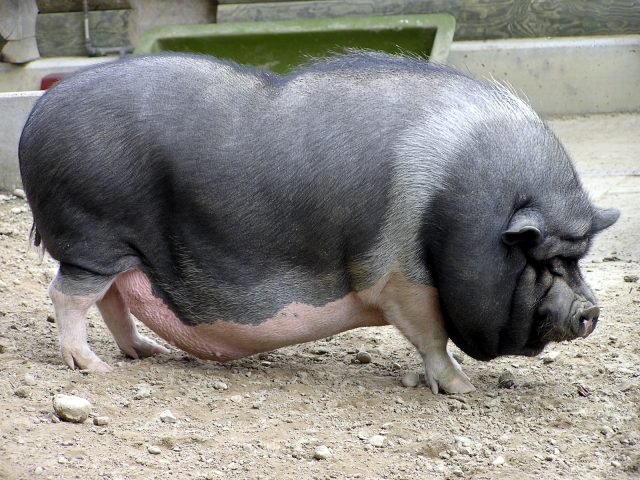Type the name of the breed you're looking for below
[wpdreams_ajaxsearchlite] Don't see the breed your're looking for? Click here and let us know!
Vietnamese Pot-bellied pig
| Place of Origin | Vietnam |
| Origin | The pot-bellied pig (Vietnamese: lợn ỉ) is a breed of domesticated pig originating in Vietnam. Today, the Vietnamese and German governments have realized that the indigenous Vietnamese pig subspecies exist only in mountainous Vietnam and Thailand. The Vietnamese government has begun to subsidize local farmers who continue to raise the indigenous pot-bellied pigs because it realizes they are neither as prolific nor as large as other breeds. |
| Purpose | Meat |
| Characteristics | Considerably smaller than standard American or European farm pigs, they weigh 43 to 136 kg (100 to 300 lb). Boars, intact male pigs, become fertile at six months of age, long before they are completely physically mature. Pot-bellied pigs are considered fully grown by six years of age, when the epiphyseal plates in the long bones of the legs finally close. Because pot-bellied pigs are the same species as ordinary farmyard pigs and wild boars, they are capable of interbreeding. Most pot-bellied pigs have been crossed with various farm pig breeds. A 2004 study by Thuy revealed extreme genetic diversity in indigenous Vietnamese pot-bellied pigs. They were also genetically different from each other according to location of origin in Vietnam. Pig breeds from developed countries were refined over centuries to a specific genetic make-up. This means a cross between a purebred Vietnamese pot-bellied and another pig type, its genetic material is more diverse and the offspring will resemble the more specific pig imports. The German Agriculture Ministry has been assisting Vietnam with its pork production by introducing large breeds of pigs into Vietnam since the mid-1980s. |
| Other Considerations | Health Many breeders recommend the spaying or neutering of both sexes at a young age if the owner does not wish to breed them. Many local laws also require licensed pet pigs to be neutered. The procedure is different from the method used in farm pigs. Neutering is said to reduce the aggression of boars and female pigs during estrus, as well as the risk of testicular cancer and uterine tumors. The hooves and tusks are also recommended to be trimmed. Abandonment Pot-bellied pigs have been abandoned when owners discover that these pigs actually grow to larger sizes and require more care than they believed. Others are forced to give up pet pigs due to local ordinances. According to Adam Goldfarb, the director of the Pets At Risk program for the Humane Society of the United States, "Pot-bellied pigs are really emblematic of what happens to an animal when it becomes a popular or fad pet. We saw this in the '90s when there was the initial pot-bellied pig craze. A lot of people went to buy them because they are so cute when they are little, but then they get big." Pot-bellied pig associations recommend adoption from local shelters instead of buying. Others like the Southern California Association for Miniature Pot-bellied Pigs and the California Pot-bellied Pig Association are actively involved in housing abandoned pet pigs. Despite this, shelters often have difficulty in finding new homes for abandoned pigs. |



